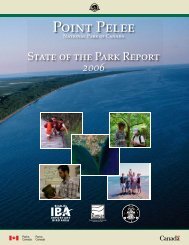The case for change: Women working in hospitality, leisure ... - LinkBC
The case for change: Women working in hospitality, leisure ... - LinkBC
The case for change: Women working in hospitality, leisure ... - LinkBC
Create successful ePaper yourself
Turn your PDF publications into a flip-book with our unique Google optimized e-Paper software.
<strong>The</strong> <strong>case</strong> <strong>for</strong> <strong>change</strong>:<br />
<strong>Women</strong> <strong>work<strong>in</strong>g</strong> <strong>in</strong> <strong>hospitality</strong>,<br />
<strong>leisure</strong>, travel and tourism<br />
Executive Summary<br />
November 2010
Foreword<br />
Natalie Bick<strong>for</strong>d<br />
HR Director UK and Ireland,<br />
Sodexo Ltd and Chair,<br />
<strong>Women</strong> 1st<br />
<strong>The</strong> <strong>hospitality</strong>, <strong>leisure</strong>, travel and tourism<br />
sector prides itself on the way it manages its<br />
people and its ability to offer its staff part-time<br />
and flexible hours. However, as this report<br />
highlights, this flexibility appears to apply more to transient and<br />
seasonal workers and is often not available <strong>for</strong> those staff who wish<br />
to pursue a career <strong>in</strong> the sector.<br />
Given that the sector needs to recruit an additional 290,000<br />
managers and 61,000 chefs <strong>in</strong> the ten years to 2017, it is critical<br />
that we maximise opportunities to reta<strong>in</strong> and develop the staff we<br />
have and, clearly, a lack of flexibility adversely affects more women<br />
than men.<br />
Recognis<strong>in</strong>g the need <strong>for</strong> more women to progress to senior<br />
management positions, and overcom<strong>in</strong>g the barriers prevent<strong>in</strong>g them<br />
from do<strong>in</strong>g so, is critical. However, if we are to successfully tackle the<br />
problem we need to build the argument on a strong evidence base<br />
that makes the bus<strong>in</strong>ess <strong>case</strong> <strong>for</strong> <strong>change</strong>. This report goes some way<br />
towards address<strong>in</strong>g this, by provid<strong>in</strong>g valuable <strong>in</strong>telligence on women<br />
<strong>work<strong>in</strong>g</strong> <strong>in</strong> our sector.<br />
Through the <strong>Women</strong> 1st programme, we have a real opportunity<br />
to address the problem head-on by build<strong>in</strong>g on <strong>in</strong>ternational<br />
best practice that provides practical solutions <strong>for</strong> <strong>in</strong>dividuals and<br />
bus<strong>in</strong>esses <strong>in</strong> our sector.<br />
Introduction<br />
Sharon Glancy<br />
Founder, <strong>Women</strong> 1st<br />
S<strong>in</strong>ce its launch <strong>in</strong> 2009, the <strong>Women</strong> 1st<br />
programme has supported over 250 women<br />
<strong>in</strong> the <strong>hospitality</strong>, <strong>leisure</strong>, travel and tourism<br />
sector with a dedicated mentor<strong>in</strong>g programme,<br />
provided by tra<strong>in</strong>ed <strong>in</strong>dustry leaders. In<br />
addition, it has put 213 through tailored<br />
development tra<strong>in</strong><strong>in</strong>g to equip them with the skills and expertise to<br />
progress their careers.<br />
In ‘<strong>The</strong> <strong>case</strong> <strong>for</strong> <strong>change</strong>: women <strong>work<strong>in</strong>g</strong> <strong>in</strong> <strong>hospitality</strong>, <strong>leisure</strong>, travel<br />
and tourism,’ we have presented the evidence base <strong>for</strong> <strong>change</strong>.<br />
<strong>The</strong> report looks at where women are <strong>work<strong>in</strong>g</strong> <strong>in</strong> the sector, the<br />
number progress<strong>in</strong>g <strong>in</strong>to management positions and some of the<br />
issues that are prevent<strong>in</strong>g them from fulfill<strong>in</strong>g their career ambitions.<br />
It also presents the critical bus<strong>in</strong>ess <strong>case</strong> <strong>for</strong> hav<strong>in</strong>g more genderbalanced<br />
senior management teams - a <strong>case</strong> which is grow<strong>in</strong>g <strong>in</strong><br />
strength. Not only does evidence suggest that it produces<br />
real f<strong>in</strong>ancial rewards, it also highlights the importance of hav<strong>in</strong>g<br />
a broader representation of women. Bus<strong>in</strong>esses with three or<br />
more female board members have been found to deliver the<br />
biggest impact.<br />
However, there is a clear disparity between the number of women<br />
<strong>work<strong>in</strong>g</strong> <strong>in</strong> the <strong>in</strong>dustry and those <strong>in</strong> management and senior<br />
positions. Data on age and dependents would suggest that those<br />
women who have car<strong>in</strong>g responsibilities take longer, or struggle,<br />
to progress to senior positions.<br />
<strong>The</strong>re are also large differences <strong>in</strong> the concentration of female<br />
workers <strong>in</strong> certa<strong>in</strong> types of occupations and areas of <strong>in</strong>dustry, which<br />
is reflected <strong>in</strong> the salaries they earn. Our research seems to suggest<br />
that the traditional image of a greater number of women <strong>in</strong> part-time<br />
roles is still prevalent.<br />
Retention data has not focused sufficiently on the reasons why<br />
women leave jobs <strong>in</strong> comparison to men, but we estimate that<br />
the 310,000 female workers our <strong>in</strong>dustry loses annually cost<br />
approximately £2.8bn <strong>in</strong> replacement recruitment and <strong>in</strong>itial tra<strong>in</strong><strong>in</strong>g.<br />
Our research has identified five key barriers which appear to be the<br />
most significant <strong>in</strong> prevent<strong>in</strong>g women’s advancement to senior roles<br />
<strong>in</strong> the sector – the difficulty of comb<strong>in</strong><strong>in</strong>g work at senior level with<br />
car<strong>in</strong>g responsibilities; a dom<strong>in</strong>ant mascul<strong>in</strong>e organisational culture;<br />
preconceptions and gender bias; a lack of net<strong>work<strong>in</strong>g</strong> and exclusion<br />
from <strong>in</strong><strong>for</strong>mal networks of communication, and a lack of visible<br />
women <strong>in</strong> senior positions.<br />
If our sector is to effectively tackle the poor gender balance of its<br />
senior teams and make the most of the bus<strong>in</strong>ess opportunities<br />
available, we must look at how best to overcome these barriers by<br />
tak<strong>in</strong>g on board best practice – both <strong>in</strong>ternationally and from other<br />
<strong>in</strong>dustries. We also need to recognise the importance of provid<strong>in</strong>g<br />
and promot<strong>in</strong>g flexible <strong>work<strong>in</strong>g</strong> arrangements <strong>for</strong> those that wish to<br />
pursue a career and not lose the talent we have worked to develop.<br />
In the New Year, we will be br<strong>in</strong>g<strong>in</strong>g out a handbook that provides<br />
<strong>in</strong>dividuals and bus<strong>in</strong>esses with <strong>work<strong>in</strong>g</strong> guidel<strong>in</strong>es and practical<br />
solutions that can help support more women to progress to senior<br />
positions.<br />
We hope you f<strong>in</strong>d this summary useful, and that it encourages you<br />
to consider your <strong>case</strong> <strong>for</strong> <strong>change</strong>.
<strong>The</strong> bus<strong>in</strong>ess <strong>case</strong> <strong>for</strong><br />
more gender-balanced<br />
management teams<br />
Increas<strong>in</strong>g evidence <strong>for</strong> more<br />
gender-balanced management teams<br />
<strong>The</strong> need <strong>for</strong> more gender-balanced management teams and boards<br />
still divides op<strong>in</strong>ion. However, an <strong>in</strong>creas<strong>in</strong>g number of studies<br />
demonstrate a clear relationship between women’s representation<br />
<strong>in</strong> senior management and boardrooms and bus<strong>in</strong>ess per<strong>for</strong>mance<br />
<strong>in</strong>dicators such as f<strong>in</strong>ancial per<strong>for</strong>mance and shareholder value. 1<br />
<strong>The</strong> Catalyst 2 report looked at the per<strong>for</strong>mance of Fortune 500<br />
companies, rank<strong>in</strong>g them by the number of female board members.<br />
It found that, <strong>in</strong> all measures, the companies with the most female<br />
board members outper<strong>for</strong>med those with the least. It found that<br />
<strong>in</strong> 2007, <strong>for</strong> companies <strong>in</strong> the top quartile, return on equity was 53<br />
percent higher; return on sales 42 percent higher; and return on<br />
<strong>in</strong>vested capital 66 percent higher than <strong>for</strong> the companies <strong>in</strong> the<br />
bottom quartile.<br />
Other studies support these f<strong>in</strong>d<strong>in</strong>gs. Research by the World<br />
Economic Forum <strong>in</strong>dicates that clos<strong>in</strong>g the male-female employment<br />
gap would have huge economic implications <strong>for</strong> developed countries,<br />
boost<strong>in</strong>g US GDP by as much as 9 percent, eurozone GDP by as<br />
much as 13 percent and Japanese GDP by as much as 16 percent. 3<br />
<strong>The</strong> power of ‘three’<br />
Whilst most data looks at women’s <strong>in</strong>dividual representation on a<br />
board, an <strong>in</strong>creas<strong>in</strong>g amount of evidence re<strong>in</strong><strong>for</strong>ces the importance<br />
of hav<strong>in</strong>g a number of women at board level – and three appears to<br />
be the magic number.<br />
<strong>The</strong> Catalyst 4 report found that Fortune 500 companies with three<br />
or more women on the board ga<strong>in</strong>ed a significant per<strong>for</strong>mance<br />
advantage over those with the fewest:<br />
• over 73 percent higher return on sales<br />
• 83 percent higher return on equity<br />
• 112 percent higher return on <strong>in</strong>vested capital<br />
Similar results were found <strong>in</strong> other research. 5 Leeds University<br />
Bus<strong>in</strong>ess School reports that hav<strong>in</strong>g at least one female director on<br />
the board appears to cut a company’s chances of go<strong>in</strong>g bust by<br />
about 20 percent. Hav<strong>in</strong>g two or three female directors lowers the<br />
risk even more.<br />
Mirror<strong>in</strong>g our customers’ perspective<br />
Demographic <strong>change</strong>s mean that women’s purchas<strong>in</strong>g power<br />
cont<strong>in</strong>ues to <strong>in</strong>crease. In the UK, women are expected to own 60<br />
percent of all personal wealth by 2025 and there are now more<br />
female millionaires between the ages of 18 and 44 than male.6<br />
A more balanced senior management team could help to ensure<br />
that the views and expectations of female customers are properly<br />
recognised and considered.<br />
1 www.closethegap.org.uk<br />
2 Catalyst, <strong>The</strong> bottom l<strong>in</strong>e: Corporate per<strong>for</strong>mance and women’s<br />
representation on boards, Catalyst, New York, 2007<br />
3 www.we<strong>for</strong>um.org<br />
4 Catalyst, <strong>The</strong> bottom l<strong>in</strong>e: Corporate per<strong>for</strong>mance and women’s<br />
representation on boards, Catalyst, New York, 2007<br />
5 <strong>The</strong> Conference Board of Canada, Canadian directorship practices 2001,<br />
<strong>The</strong> Conference Board of Canada, Canada, 2001.<br />
6 Cunn<strong>in</strong>gham, J and P Roberts (2007) Inside her pretty little head: A new<br />
theory of female motivation and what it means <strong>for</strong> market<strong>in</strong>g<br />
How are women represented<br />
<strong>in</strong> the <strong>hospitality</strong>, <strong>leisure</strong>,<br />
travel and tourism sector?<br />
Of the two million people <strong>work<strong>in</strong>g</strong> <strong>in</strong> the <strong>hospitality</strong>, <strong>leisure</strong>, travel<br />
and tourism sector, 56 percent (1,064,700) are women. However,<br />
the percentage of women <strong>work<strong>in</strong>g</strong> <strong>in</strong> the sector is fall<strong>in</strong>g - from<br />
61 percent <strong>in</strong> 2004/5 to 56 percent <strong>in</strong> 2009. This largely reflects a<br />
reduction <strong>in</strong> those occupations and sub-<strong>in</strong>dustries where there is a<br />
greater concentration of females, such as travel agents.<br />
Occupational breakdown of female employment<br />
<strong>The</strong>re are clear differences <strong>in</strong> the <strong>in</strong>dustrial breakdown of female<br />
employment. A higher proportion of females are employed <strong>in</strong> travel<br />
services (71 percent), self-cater<strong>in</strong>g accommodation, holiday centres<br />
and youth hostels (71 percent), tourist services (71 percent) and<br />
food and service management (66 percent). Conversely, there are<br />
proportionally fewer women than men <strong>work<strong>in</strong>g</strong> <strong>in</strong> visitor attractions<br />
(45 percent) and restaurants (48 percent).<br />
<strong>The</strong>re are clear gender differences across different occupations.<br />
<strong>The</strong>re are considerably more female travel agents (81 percent) and<br />
travel agency managers (64 percent). Similarly, conference and<br />
exhibition managers are dom<strong>in</strong>ated by females (73 percent) as are<br />
wait<strong>in</strong>g staff (72 percent) and travel and tour guides (69 percent).<br />
Males dom<strong>in</strong>ate <strong>in</strong> the follow<strong>in</strong>g occupations: hotel porters (100<br />
percent), chefs and cooks (61 percent) and publicans and managers<br />
of licensed premises (60 percent).<br />
Figure 1: Composition of males and females <strong>in</strong> core occupations<br />
Travel agency managers<br />
Hotel porters<br />
Travel & tour guides<br />
Leisure & theme park attendants<br />
Conference & exhibition managers<br />
Publicans & managers of licensed premises<br />
Travel agents<br />
Hotel & accommodation managers<br />
Restaurant & cater<strong>in</strong>g staff<br />
Bar staff<br />
Waiters, waitresses<br />
Chefs, cooks<br />
Kitchen & cater<strong>in</strong>g assistants<br />
Source: Labour Force Survey, 2009<br />
0% 20% 40% 60% 80% 100%<br />
Male<br />
Female<br />
Once aga<strong>in</strong>, the reasons are likely to be historic or reflect the <strong>work<strong>in</strong>g</strong><br />
patterns of that <strong>in</strong>dustry or the occupations that are found <strong>in</strong> it.<br />
When look<strong>in</strong>g at broad occupational groups, on average, 25<br />
percent of the male work<strong>for</strong>ce is employed <strong>in</strong> management or<br />
senior positions compared to 18 percent of females. This imbalance<br />
is the <strong>case</strong> <strong>for</strong> all <strong>in</strong>dustries, except <strong>for</strong> events and self-cater<strong>in</strong>g<br />
accommodation, holiday parks and youth hostels.<br />
‘Hav<strong>in</strong>g at least one female director on the<br />
board appears to cut a company’s chances<br />
of go<strong>in</strong>g bust by about 20 percent. Hav<strong>in</strong>g<br />
two or three female directors lowers the risk<br />
even more.’
Table 1: Female representation across broad occupations<br />
Male % Female % Difference<br />
Managers and senior positions 177,200 24.9 155,600 17.7 -7.3<br />
Professional occupations 6,100 0.9 3,900 0.4 -0.4<br />
Associate professional and technical occupations 18,400 2.6 24,900 2.8 0.2<br />
Adm<strong>in</strong>istrative and secretarial occupations 23,500 3.3 75,900 8.6 5.3<br />
Skilled trades occupations 136,00 19.1 46,400 5.3 -13.9<br />
Personal service occupations 23,300 3.3 71,100 8.1 4.8<br />
Sales and customer service occupations 34,800 4.9 63,500 7.2 2.3<br />
Process, plant and mach<strong>in</strong>e operatives 31,100 4.4 4,000 0.5 -3.9<br />
Elementary occupations 260,700 36.7 436,000 49.5 12.8<br />
Total 711,200 100.00 881,100 100.00 0<br />
Source: Labour Force Survey, 2009<br />
What age tells us about progression<br />
Age, when looked across broad occupational areas, provides some <strong>in</strong>dications about the speed of progression <strong>in</strong>to managerial positions.<br />
Figure 2 suggests that, at an operational level, the make-up of these occupations by age is broadly consistent regardless of gender, although<br />
there is a higher percentage of women <strong>work<strong>in</strong>g</strong> <strong>in</strong> these occupations after the age of 55.<br />
However, a different pattern emerges when we look at managers and those <strong>in</strong> senior positions (see figure 3). Until the age of 25, men and<br />
women follow the same pattern, however between 25 and 45, the pattern looks very different, with fewer women found <strong>in</strong> these positions. At<br />
its peak, 18 percent more men are <strong>in</strong> management positions. From 45 onwards the pattern converges aga<strong>in</strong>. <strong>The</strong> figures would suggest that<br />
dur<strong>in</strong>g child-rear<strong>in</strong>g age, fewer women are <strong>in</strong> management positions, compared to men. Between 65 and 69 the number of people of both<br />
sexes <strong>in</strong>creases. This reflects that there are fewer workers at this level, but of those that do stay <strong>in</strong> employment, a greater percentage of men<br />
are <strong>in</strong> employment.<br />
Figure 2: Gender and age across operational occupations Figure 3: Gender and age across managers and senior positions<br />
90%<br />
80%<br />
70%<br />
60%<br />
50%<br />
40%<br />
30%<br />
20%<br />
10%<br />
0%<br />
16-19<br />
20-24<br />
25-29<br />
30-34<br />
35-39<br />
Source: Labour Force Survey, 2009 Source: Labour Force Survey, 2009<br />
Work<strong>in</strong>g patterns and characteristics<br />
Work<strong>in</strong>g patterns<br />
40-44<br />
45-49<br />
50-54<br />
55-59<br />
60-64<br />
65-69<br />
70+<br />
MALES<br />
FEMALES<br />
<strong>Women</strong> are more likely to fill part-time roles. 54 percent of females <strong>work<strong>in</strong>g</strong> <strong>in</strong> the sector work part-time, compared to 46 percent of men.<br />
For core operational roles, men are much more likely to work full-time. In some <strong>case</strong>s there are quite significant variations, such as <strong>for</strong> chefs,<br />
wait<strong>in</strong>g staff and <strong>leisure</strong> and travel services occupations. Largely, these variations can be expla<strong>in</strong>ed by the types of <strong>in</strong>dustries that a higher<br />
proportion of women are found <strong>in</strong>, such as chefs and cooks <strong>in</strong> education cater<strong>in</strong>g.<br />
‘52 percent of the <strong>Women</strong> 1st onl<strong>in</strong>e survey respondents th<strong>in</strong>k that it is more difficult<br />
<strong>for</strong> women to move <strong>in</strong>to senior management roles <strong>in</strong> the sector than men.’<br />
50%<br />
45%<br />
40%<br />
35%<br />
30%<br />
25%<br />
20%<br />
15%<br />
10%<br />
5%<br />
0%<br />
16-19<br />
20-24<br />
25-29<br />
30-34<br />
35-39<br />
40-44<br />
45-49<br />
50-54<br />
55-59<br />
60-64<br />
65-69<br />
70+<br />
MALES<br />
FEMALES
Table 2: Full-time, part-time and female employment (United K<strong>in</strong>gdom)<br />
Chefs, cooks<br />
Travel agents<br />
Travel & tour<br />
guides<br />
Leisure &<br />
travel service<br />
occupations<br />
Male Full-time 84% 79% 16% 69% 80% 45% 41% 32% 20%<br />
Part-time 16% 20% 84% 33% 19% 54% 58% 68% 80%<br />
Total 100% 100% 100% 100% 100% 100% 100% 100% 100%<br />
Female Full-time 51% 61% 27% 27% N/A 30% 23% 23% 19%<br />
Source: Labour Force Survey, 2009<br />
Part-time 49% 39% 73% 73% N/A 71% 77% 77% 81%<br />
Total 100% 100% 100% 100% 100% 100% 100% 100% 100%<br />
However, there are also significant disparities between males and females <strong>work<strong>in</strong>g</strong> <strong>in</strong> management occupations. In particular, there are<br />
greater disparities between hotel and accommodation managers and conference and exhibition managers.<br />
Table 3: Full-time, part-time and female employment (United K<strong>in</strong>gdom)<br />
Hotel porters<br />
Hotel &<br />
accommodation<br />
managers<br />
Kitchen & cater<strong>in</strong>g<br />
assistants<br />
Conference<br />
& exhibition<br />
managers<br />
Waiters,<br />
waitresses<br />
Restaurant<br />
& cater<strong>in</strong>g<br />
managers<br />
Bar staff<br />
Publicans &<br />
managers<br />
of licensed<br />
premises<br />
Male Full-time 89% 100% 95% 90% 100%<br />
Leisure & theme<br />
park attendants<br />
Travel agency<br />
managers<br />
Part-time 11% 0% 5% 10% 0%<br />
Total 100% 100% 100% 100% 100%<br />
Female Full-time 61% 74% 82% 89% 98%<br />
Part-time 39% 26% 18% 11% 2%<br />
Total 100% 100% 100% 100% 100%<br />
Source: Labour Force Survey, 2009<br />
Dependents<br />
Across the sector, 62 percent of the female work<strong>for</strong>ce does not have any dependents under the age of 16. Proportionally, the number of<br />
female workers without dependents is roughly a quarter higher (24 percent) than those with dependents. This difference is greatest with<strong>in</strong><br />
professional occupations (56 percent) and managers and senior officials (38 percent).<br />
This means that female managers are less likely to have dependents or that their children have already grown up.<br />
Table 4: Ratio of women <strong>in</strong> broad occupational group<strong>in</strong>gs with and without dependents, United K<strong>in</strong>gdom<br />
Ratio of women <strong>in</strong> broad occupational group<strong>in</strong>g<br />
No dependants Dependants Difference<br />
1 Managers and senior positions 69% 31% 38%<br />
2 Professional occupations 78% 22% 56%<br />
3 Associate professional and technical occupations 57% 43% 14%<br />
4 Adm<strong>in</strong>istrative and secretarial occupations 56% 44% 12%<br />
5 Skilled trades occupations 62% 38% 24%<br />
6 Personal service occupations 61% 39% 22%<br />
7 Sales and customer service occupations 61% 39% 22%<br />
8 Process, plant and mach<strong>in</strong>e operatives 48% 52% -4%<br />
9 Elementary occupations 61% 39% 22%<br />
Total (average) 62% 38% 24%<br />
Source: Labour Force Survey, 2009
Recruitment and development<br />
Recruitment methods<br />
Previous research undertaken by People 1st suggests that sector recruitment tends to rely on <strong>in</strong><strong>for</strong>mal methods. Over half of employers used<br />
word of mouth (58 percent), followed by 40 percent us<strong>in</strong>g jobcentres and 36 percent us<strong>in</strong>g <strong>in</strong>ternal advertisements.<br />
Fig 4: Method of advertis<strong>in</strong>g <strong>hospitality</strong> jobs<br />
Source: People 1st, 2009<br />
Word of mouth 58%<br />
<strong>The</strong> Job Centre 40%<br />
An <strong>in</strong>ternal advertisement 36%<br />
A newspaper or journal 28%<br />
Your own website 25%<br />
An on-l<strong>in</strong>e recruitment site external<br />
to your bus<strong>in</strong>ess<br />
A recruitment agency<br />
12%<br />
16%<br />
0% 10% 20% 30% 40% 50% 60% 70%<br />
‘Research has shown that the Fortune<br />
500 companies with three or more<br />
women on the board saw more than<br />
73 percent higher return on sales, 83<br />
percent higher return on equity and<br />
112 percent higher return on <strong>in</strong>vested<br />
capital than those with the fewest<br />
female board members’<br />
<strong>The</strong> focus on more <strong>in</strong><strong>for</strong>mal networks is strongly felt to favour men. Research suggests men are more com<strong>for</strong>table net<strong>work<strong>in</strong>g</strong> and have the<br />
self-confidence necessary to take advantage of them. Similarly, women are often subconsciously excluded by such networks.<br />
Highest qualification atta<strong>in</strong>ment<br />
<strong>The</strong>re are broad variations <strong>in</strong> the highest qualification atta<strong>in</strong>ment between men and women across core occupations. For most occupations,<br />
there is little difference between male and female.<br />
However, there are a number of occupations where men have higher qualification levels. For example, male travel agents and hotel and<br />
accommodation managers are 19 percent more likely to have a qualification at level 4 or above than women.<br />
Retention<br />
People 1st estimates that the <strong>hospitality</strong>, <strong>leisure</strong>, travel and tourism sector loses approximately 310,000 female workers annually due to labour<br />
turnover, cost<strong>in</strong>g approximately £2.8bn <strong>in</strong> replacement recruitment and <strong>in</strong>itial tra<strong>in</strong><strong>in</strong>g.<br />
It is not currently clear how many of this number leave due to maternity reasons, and further research will be required <strong>in</strong> this area.<br />
However, even if a small percentage of women were able to be reta<strong>in</strong>ed and developed it would help tackle the hard-to-fill vacancies faced by<br />
employers, as well as meet<strong>in</strong>g the future demand of an expand<strong>in</strong>g sector.<br />
On average, women are stay<strong>in</strong>g with their current employer <strong>for</strong> 4.68 years. This means that <strong>for</strong> every female employee leav<strong>in</strong>g the sector,<br />
employers will have spent <strong>in</strong> the region of £10,468 per person on their recruitment and on-go<strong>in</strong>g skills development. Across the whole sector,<br />
employers would have spent approximately £3.2bn a year, based on the 310,000 female employees leav<strong>in</strong>g the sector.<br />
Earn<strong>in</strong>gs<br />
<strong>The</strong> disparity between men and women’s earn<strong>in</strong>gs cont<strong>in</strong>ues to be highlighted <strong>in</strong> the figures. Men are paid more across all occupations, with<br />
the exception of conference and exhibition managers and travel and tour guides. However, male restaurant and cater<strong>in</strong>g managers and hotel<br />
and accommodation managers are paid significantly more than women.
Table 5: Pay and gender across core occupations, United K<strong>in</strong>gdom<br />
SIC code def<strong>in</strong>ition Gross weekly pay <strong>in</strong> ma<strong>in</strong> job<br />
(MALE)<br />
Gross weekly pay <strong>in</strong> ma<strong>in</strong><br />
job (FEMALE)<br />
Percentage difference<br />
between male and<br />
female earn<strong>in</strong>gs<br />
Hotel & accommodation managers £490 £325 16.8%<br />
Conference & exhibition managers £518 £551 -3.2%<br />
Restaurant & cater<strong>in</strong>g managers £581 £352 19.7%<br />
Publicans & managers of licensed premises £377 £186 25.3%<br />
Chefs, cooks £333 £174 23.8%<br />
Travel agents £386 £256 16.8%<br />
Travel & tour guides £79 £84 -3.1%<br />
Leisure and travel service occupations £418 £159 30.9%<br />
Hotel porters £360 No data -<br />
Kitchen & cater<strong>in</strong>g assistants £170 £139 9.1%<br />
Waiters, waitresses £156 £131 8.0%<br />
Bar staff £126 £118 3.2%<br />
Leisure & theme park attendants £204 £82 29.7%<br />
Source: Labour Force Survey, April-June 2010 (<strong>in</strong>come weight<strong>in</strong>g used)<br />
Barriers prevent<strong>in</strong>g more women enter<strong>in</strong>g<br />
senior management positions <strong>in</strong> the sector<br />
Research conducted by People 1st <strong>in</strong> 2010 concluded that the follow<strong>in</strong>g five barriers appear to be the most significant <strong>in</strong> prevent<strong>in</strong>g women’s<br />
advancement to senior roles 7 :<br />
1. Difficulty of comb<strong>in</strong><strong>in</strong>g work at senior level with car<strong>in</strong>g responsibilities<br />
2. Dom<strong>in</strong>ant mascul<strong>in</strong>e organisational culture<br />
3. Preconceptions and gender bias<br />
4. Lack of net<strong>work<strong>in</strong>g</strong> and exclusion from <strong>in</strong><strong>for</strong>mal networks of communication<br />
5. Lack of visible women <strong>in</strong> senior positions<br />
<strong>The</strong>se five factors do not operate alone and, <strong>in</strong> reality, they re<strong>in</strong><strong>for</strong>ce one another through a variety of social, bus<strong>in</strong>ess and <strong>in</strong>dividual factors.<br />
1. Difficulty of comb<strong>in</strong><strong>in</strong>g work at senior level with car<strong>in</strong>g responsibilities<br />
Work-home balance is a struggle <strong>for</strong> both men and women. On average, European women devote twice as much time to domestic tasks as<br />
men: four hours and 29 m<strong>in</strong>utes per day, compared with two hours and 18 m<strong>in</strong>utes from the men <strong>in</strong> the sample. 8<br />
Undoubtedly, comb<strong>in</strong><strong>in</strong>g work and car<strong>in</strong>g responsibilities is the most significant factor prevent<strong>in</strong>g women from progress<strong>in</strong>g to higher positions<br />
(cited by 70 percent of respondents to the <strong>Women</strong> 1st onl<strong>in</strong>e survey).<br />
This might seem strange <strong>for</strong> a sector that offers a lot of part-time and flexible jobs that do not fit traditional hours. However, these opportunities<br />
are not normally available <strong>for</strong> those who want to pursue a career <strong>in</strong> the sector (male or female) and tend to only be open to the large number of<br />
transient workers the sector attracts to fill front-fac<strong>in</strong>g, lower skilled roles.<br />
“For some women, unlike men, there comes a po<strong>in</strong>t where they choose to come off the track; you can’t deny that, <strong>for</strong> some women, they get<br />
married and have children and either don’t want to work or their career is not as important as it was… men are often s<strong>in</strong>gle-m<strong>in</strong>dedly focused<br />
on their career.” (Female senior manager, <strong>hospitality</strong>, <strong>leisure</strong>, travel and tourism (HLTT) sector)<br />
2. Dom<strong>in</strong>ant mascul<strong>in</strong>e organisational culture<br />
With women traditionally be<strong>in</strong>g largely absent from senior management positions, organisational culture can be perceived by some as be<strong>in</strong>g<br />
mascul<strong>in</strong>e. Just under a quarter of the <strong>Women</strong> 1st onl<strong>in</strong>e survey respondents said that a dom<strong>in</strong>ant male culture and attitude is a h<strong>in</strong>drance to<br />
mov<strong>in</strong>g up the career ladder.<br />
<strong>The</strong>re are also those who believe that some women can adopt perceived mascul<strong>in</strong>e traits to progress, so hav<strong>in</strong>g more women at senior levels<br />
is not necessary the sole solution.<br />
“I def<strong>in</strong>itely th<strong>in</strong>k that a predom<strong>in</strong>antly male macho culture is a big issue - it seems that even some of the women on the senior management<br />
team are emulat<strong>in</strong>g their peers or are treat<strong>in</strong>g their staff <strong>in</strong> the same way they have been treated by their bosses.” (<strong>Women</strong> 1st onl<strong>in</strong>e survey<br />
respondent)<br />
7 Research consisted of an onl<strong>in</strong>e survey, qualitative <strong>in</strong>terviews with senior women <strong>in</strong> the <strong>hospitality</strong>, <strong>leisure</strong>, travel and tourism sector and desk research<br />
8 “A statistical view of the life of women and men <strong>in</strong> the EU-25,” data from 15 countries, Eurocast (2006)
3. Preconceptions and gender bias<br />
We make small judgments about <strong>in</strong>dividuals every day, based on<br />
assumptions that arise automatically. <strong>The</strong>se brief <strong>in</strong><strong>for</strong>mal <strong>in</strong>teractions<br />
can accumulate and, ultimately, impact <strong>for</strong>mal employment decisions.<br />
Gender bias is our assumptions about the characteristics of men and<br />
women. 9<br />
<strong>The</strong>se judgments can be made by both managers and <strong>in</strong>dividuals and<br />
are often unconscious. <strong>The</strong>y can affect women’s progression <strong>in</strong> a<br />
number of ways:<br />
Perception that family responsibilities will <strong>in</strong>terfere<br />
It has been argued that one of the strongest and most explicit<br />
bias <strong>in</strong> today’s workplace is aga<strong>in</strong>st mothers. 10 It is triggered when<br />
motherhood becomes obvious to managers and colleagues. This<br />
typically occurs when a woman announces that she is pregnant,<br />
returns from maternity leave, or adopts a part-time or flexible<br />
schedule.<br />
“I th<strong>in</strong>k I did face barriers, although I don’t th<strong>in</strong>k men did it<br />
<strong>in</strong>tentionally, but when I had my children I th<strong>in</strong>k there was just an<br />
assumption that I was not so <strong>in</strong>terested <strong>in</strong> my career because I had<br />
other th<strong>in</strong>gs go<strong>in</strong>g on. That was not meant to be malicious <strong>in</strong> any<br />
way, it was just an assumption. Aga<strong>in</strong> I had to make it very clear that,<br />
because my husband was at home, I did not see that my career was<br />
on hold and that I was still on track.” (Female senior manager,<br />
HLTT sector)<br />
Job descriptions and adverts<br />
<strong>The</strong> way <strong>in</strong> which job descriptions are designed and worded, and<br />
where they are advertised, may put women off.<br />
Bus<strong>in</strong>ess psychology studies suggest that women will research new<br />
job roles thoroughly and critically assess their own competence<br />
be<strong>for</strong>e apply<strong>in</strong>g. In comparison, men tend to possess a ‘can-do’<br />
attitude and are prepared to ‘give it a go,’ even if they are not<br />
confident of the outcome. 11<br />
Recruit<strong>in</strong>g <strong>in</strong> one’s own image<br />
Subconsciously, managers can recruit <strong>in</strong> their own image. One human<br />
resources director <strong>in</strong>terviewed by People 1st found that research<br />
with<strong>in</strong> their own company revealed that female managers’ teams were<br />
split more equally <strong>in</strong> terms of gender, while male managers’ teams<br />
tended to be skewed more towards men.<br />
“It’s not that people consciously look <strong>for</strong> somebody that is like them,<br />
it’s that they feel a connection with people that are like them and I<br />
th<strong>in</strong>k when you’re <strong>in</strong>terview<strong>in</strong>g it’s extremely difficult to untangle that<br />
from whether someone is really right <strong>for</strong> the job.” (Female senior<br />
manager, HLTT sector)<br />
“<strong>The</strong>re are more men at senior level to choose from <strong>for</strong> each job that<br />
becomes available. I believe, when men are recruit<strong>in</strong>g, they are more<br />
com<strong>for</strong>table employ<strong>in</strong>g men <strong>in</strong> senior roles than females.” (<strong>Women</strong> 1st<br />
survey respondent)<br />
4. Lack of net<strong>work<strong>in</strong>g</strong> and exclusion from<br />
<strong>in</strong><strong>for</strong>mal networks of communication<br />
Net<strong>work<strong>in</strong>g</strong> is critically important <strong>in</strong> career progression, but research<br />
suggests that women are be<strong>in</strong>g excluded by some critical networks<br />
and that some may lack the confidence to network.<br />
Research by Opportunity Now has highlighted that non-executive<br />
directors are often recruited through an ‘old boys’ network’ among<br />
bus<strong>in</strong>ess and personal contacts of current board members.<br />
9 www.hrmreport.com<br />
10 www.worklifelaw.org<br />
11 www.adept-psychology.co.uk<br />
12 <strong>Women</strong> <strong>in</strong> leadership: A European bus<strong>in</strong>ess imperative, Catalyst<br />
Conference Board (2002)<br />
“At board level, typically, there will be manag<strong>in</strong>g directors, f<strong>in</strong>ancial<br />
directors, sales directors, human resources directors and operations<br />
directors. I would say that, out of those positions, there are far more<br />
men <strong>in</strong> them. In hotels, the area most represented by women will<br />
be HR, quite a few women have got <strong>in</strong>to the boardroom through<br />
sales, but there are a lot of men <strong>in</strong> sales at that level also. Most of the<br />
directors come from with<strong>in</strong>, so there are less women <strong>in</strong> the potential<br />
audience, but I th<strong>in</strong>k <strong>in</strong> some organisations there is a bit of an old<br />
boys’ network.” (Female senior manager, HLTT sector)<br />
“I f<strong>in</strong>d the lack of women that come through when I do senior level<br />
recruitment quite frighten<strong>in</strong>g.” (Search consultant <strong>for</strong> senior roles)<br />
However, often the biggest barrier prevent<strong>in</strong>g women attend<strong>in</strong>g<br />
net<strong>work<strong>in</strong>g</strong> events is the fact that they take place <strong>in</strong> the even<strong>in</strong>g or<br />
early <strong>in</strong> the morn<strong>in</strong>g, which often clashes with car<strong>in</strong>g responsibilities.<br />
5. Lack of visible women <strong>in</strong> senior positions.<br />
<strong>The</strong> low number of senior female managers <strong>in</strong> the sector means<br />
that, naturally, there are fewer female <strong>in</strong>spirational role models and<br />
mentors.<br />
34 percent of respondents to the <strong>Women</strong> 1st onl<strong>in</strong>e survey said that<br />
a lack of mentors is a h<strong>in</strong>drance <strong>for</strong> them <strong>in</strong> mov<strong>in</strong>g up the career<br />
ladder. Other studies have uncovered a similar problem, but have<br />
also highlighted the difference between male and female managers’<br />
perception of the importance of mentor<strong>in</strong>g - 61 percent of women see<br />
the lack of mentor<strong>in</strong>g as a barrier to career development, as opposed<br />
to 31 percent of men. 12<br />
<strong>The</strong> effect of a low number of senior female managers is also felt<br />
by those <strong>in</strong> these senior positions. It can mean that some women<br />
become <strong>in</strong>creas<strong>in</strong>gly isolated the higher up the organisation they<br />
progress.<br />
“I spent many years be<strong>in</strong>g the only women on a leadership team,<br />
which can be lonely.” (Female senior manager, HLTT sector)<br />
People 1st<br />
Second Floor,<br />
Armstrong House<br />
38 Market Square<br />
Uxbridge UB8 ILH<br />
United K<strong>in</strong>gdom<br />
Tel: 01895 817000<br />
Fax: 01895 817035<br />
women1st@people1st.co.uk<br />
www.people1st.co.uk/women1st










